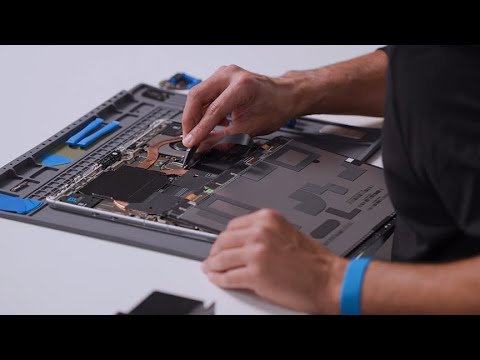Repair | Surface Pro 10 - 5G

Hello everyone. My name is Amit Bhinde and I'm a mechanical engineer on the Surface Pro team at Microsoft. Today we will be disassembling and reassembling the new Surface Pro 10 5G.
This is our most repairable 5G Surface device. This process looks very similar to the Surface Pro 10 for Business, and has the same improvements that enable easier repair, including wayfinding markings in the device and on the packaging to help differentiate screws and parts. Detailed instructions and safety guidelines are available in the service guide, which are posted on the Microsoft Support site. Repairs should be performed on an ESD work surface with grounding to protect the units.
We will wear the ESD band now to make sure we are well grounded. Additionally, we recommend removing jewelry such as watches and rings and tying back long hair. First, make sure the device is unplugged from the power and turned off before beginning.
The tools needed for both disassembly and reassembly are a metric ruler, nylon spudger, ESD-safe tweezers, plastic opening tool, 3mm Allen key, Philips number one screwdriver, 3IP Torx plus screwdriver, cleaning swabs, isopropyl alcohol, and microfiber cloth. For display removal, we will use a display debonding tool and two in-spring clamps. For display reassembly, we will use a display bonding frame, which comes with a foam pad that we will use and approximately 32kg of weight.
In this video, we will use the recommended ruck weights. For kickstand reassembly, we will use Loctite 7649 and Loctite 243 thread locker. All tools and materials are available for purchase on iFixit. First, we will remove the SSD.
This also triggers a battery shutdown of the device to make sure power is not flowing during repair. So this is step one for almost all repairs. Press your finger on the divot to open and remove the SSD door.
The SSD is now exposed. Using a 3IP screwdriver, remove the screw. The SSD can be disconnected and removed with the help of a plastic opening tool. We will set it aside on our ESD-safe surface.
Next, we will remove the display. I'll start by flipping the device over. We will start by preparing the display debonding tool which is shown right here. We recommend using this tool to reduce the risk of display damage and preserve the display for reuse while performing replacement of internal components. Using the ruler, I have already marked two lines on the pick at two millimeters and eight millimeters. This will help us ensure that we do not damage anything internally in the process.
I have already placed the guitar pick inside of the debonding tool and assembled both parts of the tool with a Phillips screwdriver. The depth of the opening pic is aligned with the top surface of the tool. We will first cut through the adhesive all around the device using this setting. Mount the debonding tool to your work surface with the clamps.
To see more detailed directions on the debonding process, check out the Surface Guide or the Surface Pro 10 for Business repairability video. Using the plastic opening tool, gently run it through the insertion points to prepare it for the debonding process. To start the deep bonding process, hold the device with both hands and insert the opening pick into the right side speaker mesh.
This will be our entry point to the device. Push the device to the right to cut the adhesive. You can push it side to side on each edge to ensure the adhesive is cut.
When you get to the corners, turn it accordingly and continue cutting through on all edges. For the top edge, it is normal to expect more resistance due to the cameras. After cutting through all edges with two millimeter depth, change the opening pick depth to eight millimeters.
This change in depth is only for the top edge. We will then set the device flat and carefully separate the display from the enclosure. You may use the opening pick to assist in separating residual adhesive that is still stuck. Be careful as you lift it because of the FPC connection. Flip the display and lay it on the bottom edge. Next we will disconnect the display from the motherboard.
Remove the shield using tweezers by lifting at the corners. Finally, using the spudger, disconnect the FPC from the top corner. Since we will reuse the display, remove any residual adhesive from the enclosure and display, it can be easily peeled away.
Before moving on, we will install the battery protective cover while we work on other parts. Next we will remove the Surface Connect Cable. This is the charging port of the device. The cable is attached with two screws on the right hand, adhesive in the middle cable area, and a connector on the motherboard.
Using a plastic opening tool, disengage the latch and then pull out the left end of the cable to disconnect it from the motherboard. Remove the two screws on the right of the cable using a 3IP screwdriver. These screws are labeled with the lightning icon to represent the charging port. Note that this connector is magnetic, so be careful when removing the screws as they might get attached to it. Next, starting on the left side, slowly peel off the cable until it becomes free. Be careful not to deform the fan cover. Since we will be
reusing the Surface Connect Cable, peel off the adhesive using tweezers. Next, we will remove the speakers. Let's start with the one on the left.
Remove three screws with the 3IP driver. These screws are labeled with a volume icon to represent the speakers. Lift the speaker out of the device. Moving to the right speaker, remove three screws with the 3IP screwdriver. Carefully lift the speaker out of the device.
Next we will remove the buttons. This step includes the power and the volume buttons and the mini PCB dedicated to them. The spare part offered allows user to replace these parts. Remove the button board by removing the two screws with the 3IP driver. These screws are labeled with a button icon to represent the buttons. Finally, remove the board and set it aside.
We will then remove the retention clips, keeping the buttons in place. Insert tweezers in the enclosure opening and apply a light upward force. The clips will snap off. These clips will not be reused.
We will use new ones during reassembly. Next, push the buttons out of the enclosure. Since we will be reusing the button board, using IPA and cleaning swabs, clean any residual tape from the bottom edge of the board. Next we will remove the thermal module. This acts as a heat sink for the device. Remove the large shield using tweezers by lifting at the corners.
We will not reuse this shield as it's deformed while removing. Next, we will disconnect the fan from the motherboard using tweezers. Lift the latch and pull off the FPC from behind.
Finally, to remove the thermal module, we will remove 11 screws using the 3IP driver. These screws are labeled with a thermometer icon to represent the thermal module. Using the plastic opening tool, gently lift at the edges to separate the thermal pad on the motherboard from the thermal module. Using both hands, lift and remove the thermal module.
Be careful not to deform the heat pipe. Next we will remove the microphone module. First we will remove the three shields to access the connections to the motherboard.
Peel off the long foam that covers these three shields. Using tweezers, gently lift at the corners until the shields pop off. Using the spudger, disconnect three FPCs starting from left. We will disconnect the first, second and the last FPC. Next, remove four screws with the 3IP driver from the module. These screws are labeled with a microphone to represent the microphone module.
Carefully lift it out of the device. Using IPA and cleaning swabs, clean the T-putty on the enclosure. I will not be demonstrating this for time's sake and the purpose of this high level overview. By removing the microphone module, we have located the front facing and the rear facing camera. We will remove those next.
Since we are reusing the front facing camera, install the camera cover on top. Disconnect the rear facing camera connection to the motherboard. Remove two screws using the 3IP driver. These screws are labeled with a camera icon to represent the rear facing camera.
For the front facing camera, we will start by disconnecting its connection to the motherboard too. This camera is glued to the enclosure, so we will use the plastic opening tool for removal. Position it under the FPC and gently lift up as you see the camera start to separate from the enclosure. Be careful not to damage the FPC if you are not replacing the camera. Remove any residual adhesive from the enclosure and the camera. Next, we will remove the Nano-SIM connector.
We will start by sliding the battery protection plate over so we can expose the Nano-SIM area. We will then remove the tape that holds the Nano-SIM FPC down. Next, using a 3IP driver, we will remove the three screws for the connector and the bracket. These screws are marked with a SIM card symbol for easy identification. Next, using a tweezer, remove the shield that covers the Nano-SIM connector by lifting it up. Disconnect the FPC from the SSD FPC using a spudger.
Lastly, slide the connector out carefully and lift it out of the device. Next, we will remove the motherboard. We will start by removing the four small shields that hold the coax cable down. Next, remove the shield and disconnect the SSD FPC using a spudger. We will then disconnect everything from the motherboard. One coax cable from the top right.
Three coax cables from the bottom right. Two coax cables coming from bottom left. 5G antenna FPC connector. Battery FPC connector along the bottom edge of the board.
Using a plastic opening tool. Disconnect the coax cables using a spudger. Disconnect the antenna and the battery.
Lastly, remove ten screws with the 3IP driver. These screws are labeled with an integrated circuit to represent the motherboard. To remove it, tilt the motherboard slightly, then slide it to the right and tilt it back up to be able to lift it out. This way the USB ports come free from the enclosure.
Since we are reusing the motherboard using IPA and cleaning swabs, clean any residual thermal material from the main chip area. And finally we will remove the battery. Remove eight screws with the 3IP driver. We also recommend that you count screws and place them away from your device as you go along. This is to ensure that there will be no loose screws remaining inside your device when it comes time to reassemble it.
We want to avoid causing any possible damage to the battery or to avoid creating any other unsafe conditions. Lift the battery out of the enclosure and set it aside by grabbing the frame from the sides. Be careful to only handle the battery by the frame on the sides. Also note to always protect the battery from accidental pokes, impact and bends during repair.
And account for all screws upon completion of the repair. Clean any residual tape and adhesive on the enclosure. Congrats! We have successfully disassembled everything. We will disassemble and reassemble the kickstand after putting the device back together at the end. Now we will begin reassembly.
Collateral such as screws, tapes, foams and adhesives will be replaced with the new ones provided in the kit. The screw bags have the same wayfinding icons to help differentiate screws. Some have dash numbers as some parts have multiple screws and they define the order of assembly. We will start with the battery.
Lift the battery from the sides and install it in the enclosure. Be careful to only handle the battery by the frame on the sides. Also note to always protect the battery from accidental pokes, impact and bends during repair. And account for all screws upon completion of repair. Fasten eight screws with the 3IP driver along the edge of the battery, labeled as -1 in the service guide and on the screw bag. Next, fasten one screw with a 3IP driver near the battery connector labeled as -2 in the service guide and screw bag. Reinstall the battery protective cover.
Next, we will install the motherboard. Be careful during this step to ensure the coax cables and battery connector are not trapped under the board. Tilt the motherboard to the front and insert the motherboard tongues into the enclosure openings. Then lower the motherboard and slide it to the left to slide the USB connectors into the enclosure first. Watch out for the coax cables, FPCs and battery connectors.
Reassemble the SSD, antenna and battery connectors. Reassemble and route the coax cables and reconnect to motherboard. Finally install ten screws with the 3IP driver.
Next, we will install the Nano-SIM connector. Install the Nano-SIM connector by placing it in the bucket cavity. Connect the Nano-SIM FPC back to the SSD FPC, and install the retention bracket over this connection.
Using a 3IP driver, install the bottom screw. Put the shield with the foam over the connector and install the top screw using the same 3IP driver. Lastly, apply the black tape to hold the Nano-SIM FPC down by using bucket markings as placement guide. Next we will reassemble the cameras and the microphone module. Starting with the front facing camera, install a new sheet of adhesive on the enclosure.
Press on the adhesive for 10 seconds. Remove the top liner. Align and install the front camera. Press on the sides of the camera for 10 seconds. Reconnect the FPC to the motherboard.
Next, reassemble the rear facing camera in the enclosure. Fasten two screws with a 3IP driver. Reconnect the FPC to the motherboard. Finally, we will install the microphone module on top.
First dispense T-putty on the enclosure. Press on half a tick mark of T-putty in this location. Remove the front camera cover before moving on. Assemble the module on top. Fasten four screws with a 3IP driver and reconnect the FPCs to the motherboard. We will now install the camera shield to finish the installation of these parts.
Next we will reassemble the speakers. Install the speakers and fasten three screws each with the 3IP driver. Next we will install the thermal module.
First we will clean the thermal module before installing new thermal pads. Remove and clean the thermal pads and material from the backside of the thermal module. Reapply two pads of thermal module.
We will place another thermal pad for main chip on the motherboard. I will not be demonstrating this for time's sake and the purpose of this high level overview. Once all three pads are accounted for and installed, reassemble the thermal module on top of the motherboard. We will then install 11 screws. There are four types of screws, so we will start with one labeled with -1, and then work our way to -4 as shown in the service guide and on screw bags.
The four central screws on the chip should be installed like an X. Finally, connect the fan FPC back to the motherboard. Reapply two of the thermal pads to the module. We will place another pad on the main chip of the motherboard. I will not be demonstrating this for time's sake.
Please refer the service guide for full details. Next we will reassemble the buttons and the button board. We will use a new retention clip in this step. Install the power and volume buttons into the enclosure and install the retention clip on top until it clicks. Next we will reassemble the button board and fasten two screws with a 3IP driver. Install foam on top of the button board by lining it up to the left edge.
Finally, we install the last internal component, the Surface Connect Cable. Start by applying new adhesive to the back side of the cable. Leave the liner on for now. I'm not going to be showing this step in the interest of time. Insert the left side into the connector of the motherboard. Next, insert the right side into the enclosure and secure using two screws with a 3IP driver.
Once the sides are secured, remove the liner. Press down on the cable starting from left and working your way to the right. Make sure the cable is pressed flat on the thermal module.
For a detailed look at reassembly of the display, please refer to the service guide or the Surface Pro 10 for Business repairability video. The only difference between this and the Surface Pro 10 for Business is the lack of shielding tape on the shield. Also, for the kickstand, disassembly and reassembly, please refer to the same Surface Pro 10 for Business video. Congrats! We have successfully reassembled the entire device.
A few things to remember during repair. Review the service guide for guidance on what needs to be removed for access to other components. During disassembly and reassembly, count screws to ensure the correct number has been removed and reinstalled.
Make sure there aren't any screws or foreign objects inside the device, especially near magnets or the battery region. Look for wayfinding markings to guide you on where to install screws and the quantity. I hope you found this video useful. Check the Microsoft site for more information or to learn more more about Microsoft's sustainability efforts.
2024-12-22 17:18


